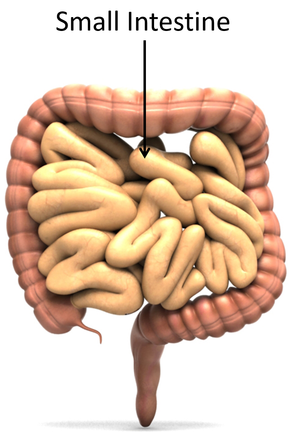Difference between revisions of "Small Intestine"
(→About The Small Intestine) |
(→About The Small Intestine) |
||
| Line 23: | Line 23: | ||
: The [[Small Intestine]] is long and folded to increase the [[Surface Area|surface area]]. | : The [[Small Intestine]] is long and folded to increase the [[Surface Area|surface area]]. | ||
: The [[Small Intestine]] has structures called [[Villi]] which are extra folds in the surface to increase the [[Surface Area|surface area]]. | : The [[Small Intestine]] has structures called [[Villi]] which are extra folds in the surface to increase the [[Surface Area|surface area]]. | ||
| − | : The [[blood]] supply to the [[villi]] in the [[Small Intestine]] is very good to constantly supply [[blood]] with little [[nutrients]] keeping a high [[Concentration Gradient|concentration gradient]] between the food and the [[blood]]. | + | : The [[blood]] supply to the [[villi]] in the [[Small Intestine]] is very good in order to constantly supply enough fresh [[blood]] with little [[nutrients]] keeping a high [[Concentration Gradient|concentration gradient]] between the food and the [[blood]]. |
: There is around 1kg of [[Bacteria in Digestion|bacteria]] inside the '''small intestine''' which helps [[digestion|digest]] the food. | : There is around 1kg of [[Bacteria in Digestion|bacteria]] inside the '''small intestine''' which helps [[digestion|digest]] the food. | ||
: Only small [[molecule]]s can be [[Absorb (Biology)|absorb]]ed into the [[blood]] through the wall of the '''small intestine'''. | : Only small [[molecule]]s can be [[Absorb (Biology)|absorb]]ed into the [[blood]] through the wall of the '''small intestine'''. | ||
Revision as of 11:59, 5 June 2019
Contents
Key Stage 2
Meaning
The small intestine is part of the digestive system.
Key Stage 3
Meaning
The small intestine is an organ in the digestive system which absorbs nutrients into the blood.
About The Small Intestine
- The small intestine is a very long tube to give a large surface area to absorb nutrients.
- There is around 1kg of bacteria inside the small intestine which helps digest the food.
- There are digestive enzymes in the small intestine which break down large molecules into smaller molecules.
- Only small molecules can be absorbed into the blood through the wall of the small intestine.
Key Stage 4
Meaning
The small intestine is an organ in the digestive system which absorbs nutrients into the blood.
About The Small Intestine
- The Small Intestine is where food is broken down by digestive enzymes including amylase, protease and lipase before being absorbed into the blood.
- The Small Intestine produces some of its own digestive enzymes including amylase and peptidase but also takes some digestive enzymes from the pancreas including pancreatic amylase, trypsin and lipase.
- The Small Intestine is long and folded to increase the surface area.
- The Small Intestine has structures called Villi which are extra folds in the surface to increase the surface area.
- The blood supply to the villi in the Small Intestine is very good in order to constantly supply enough fresh blood with little nutrients keeping a high concentration gradient between the food and the blood.
- There is around 1kg of bacteria inside the small intestine which helps digest the food.
- Only small molecules can be absorbed into the blood through the wall of the small intestine.
